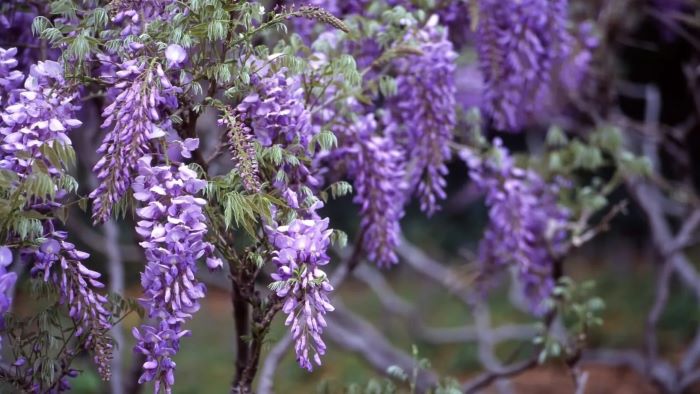Dogs have a weird habit of eating anything they see. Call it curious behaviour or their naughtiness but for paw parents, this is nothing less than a headache. Your dog tends to eat everything and you cannot even control this.

Dog’s weird habits can lead them to danger. Especially with plants, be it walk time or playtime, the plants across the way or in the garden are consumed by dogs playfully. But how do we know if these plants are actually safe for dogs or not?
Wisteria is one such plant, which is grown in gardens to add beauty to it. But what if your dog eats wisteria? Is it toxic to them? Here in this blog, we will provide you with answers to all your questions.
What Is Wisteria?
Wisteria being a native of Asia and North America is a flowering plant belonging to the pea family. It can grow about 30 feet long and produces amazing purple, blue, white and pink flowers.

Wisteria has four main species:
- Wisteria sinensis[1] also known as Chinese wisteria,
- Wisteria frutescens popular as American wisteria,
- Kentucky wisteria or Wisteria macrostachya
- Wisteria floribunda widely known as Japanese wisteria
All four species differ from each other in terms of size, shape, blooming time and colour. Chinese and Japanese wisteria have a bunch of long flowers which bloom before their leaves.
Wisteria can generally be planted in spring and requires sunny weather and well-drained soil to sustain and grow.
Is Wisteria Toxic for Dogs?
Yes, Wisteria is toxic for dogs[2], it contains two toxins lectin and wisterin which may have serious effects on your dog’s health.
Lectin: Lectin binds the blood cells making them lump together. It protects the plant from fungus growth. Lectin can affect the digestive system of dogs and even cause blood clots in them.
Wisterin: Wisterin is a triterpene glycoside which affects the dog’s nervous system causing weakness, dizziness, coma and in the worst case even death.
A dog can consume wisterin by consuming its flower, pods or seeds. If your dog consumes more than five seeds of wisteria there is a high chance of it affecting its health adversely.
Symptoms of Wisteria Poisoning in Dogs
Here are some symptoms of Wisteria poisoning in dogs:

- Blood vomiting
- Dehydration
- Stomach pain
- Diarrhea, severe or bloody
- Collapse
- Dizziness
- Nausea
- Confusion
Treatment of Wisteria Poisoning in Dogs
Here are some ways to treat Wisteria poisoning in dogs:

- Make your dog vomit using hydrogen peroxide solution. Doing this will help your dog remove the consumed Wisteria, slightly lowering the fatal danger.
- Try administrating the activated charcoal within 2 hours of your dog consuming the Wisteria. Charcoal is proven to absorb the toxins thus preventing it from entering the blood.
- Keep your dog hydrated. After consumption of Wisteria, it is very necessary to give your dog constant fluid to prevent dehydration. It helps in restoring the balance of the body.
- Giving your dog laxatives is also helpful in treating the effects of Wisteria poisoning. It is often given while administrating the activated charcoal.
How Can I Avoid My Dog Eating Parts of Wisteria?
To prevent your dog from eating parts of Wisteria, you can follow the following steps:
- Fencing the area covered with Wisteria is one way to prevent your dog from eating it. Make sure that the fence has no space or loopholes for your dog to reach the plant. By doing so Wisteria can be made less accessible to your dog.
- When the faded flowers of Wisteria fall on the ground the seeds from it tend to grow. Thus removing the faded flowers before they fall on the ground will prevent the further Growth of another plant. By doing so, the number of Wisteria can be limited and will be easy to cover.
As mentioned by Paul Frysh, Senior Health Editor webmd, "Keep poisonous plants away from pets. Clear up any leaves and other debris that might tempt them. Call your vet or an emergency vet if you think your animal has eaten something toxic, especially if they show signs of illness."
- Train your dog to avoid eating to avoid eating plants. Training a dog is a very important and crucial step, which helps in managing your dog rightly.
- Cut down the Wisteria plant. If your dog even after following all the above steps still continues to eat the plant then the ultimate option is to cut it down from its roots. Some people don’t like cutting down plants, but if you own a dog then you have to do it to safeguard him.
FAQs
Do dogs like to eat wisteria?
Dogs generally don’t have any specific liking about what to eat and what not to. They can eat anything and everything depending on their curiosity. This curious behaviour of dogs leads them to eat whatever they see. The same goes for wisteria too, dogs don’t eat them out of liking but may surely eat them based on curiosity.
Is wisteria sinensis poisonous to dogs?
Yes, wisteria sinensis also known as Chinese wisteria is toxic to dogs. It contains harmful toxins which can affect the dog’s health adversely. Consuming this wisteria sinensis can cause the worst health issues like blood clots, stroke and even in some cases death.
Can wisteria kill a dog?
Yes, wisteria can definitely kill a dog. The toxins in wisteria can lead to fatal diseases and conditions like stroke, diarrhoea, vomiting and even in the worst-case scenario even death of your dog. So if your dog has mistakenly consumed wisteria then it is necessary to consult a vet immediately.
How much wisteria is toxic to dogs?
Even though a single wisteria seed is toxic to dogs, consuming one or two seeds will cause vomiting, diarrhoea and gastrointestinal diseases in dogs. But if your dog has consumed more than five wisteria seeds then it can lead to life-threatening consequences.
What to do if a dog eats wisteria?
If your dog has consumed wisteria then try to make him vomit it out immediately and consult a vet. If you are not sure about your dog’s wisteria consumption then wait and keep a close watch on your dog, upon noticing any symptoms seek immediate medical guidance.
Conclusion
Wisteria is a plant which is severely toxic to your dog. Its effects on your dog’s health are more than you can ever imagine. It does just not lead to adverse effects on your dog’s health but can ultimately lead to his death.
Plants does enhance the beauty of our house, but being a pet parent it should be your moral responsibility to look after your pet and think about their betterment first. Avoid planting any plants that are toxic for dogs.
If your dog has consumed Wisteria or shows any symptoms of poisoning consult a vet immediately.
Reference:



